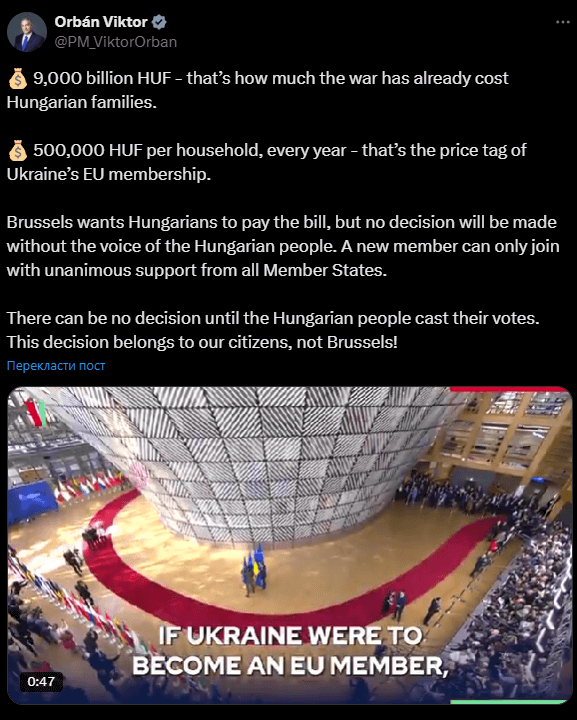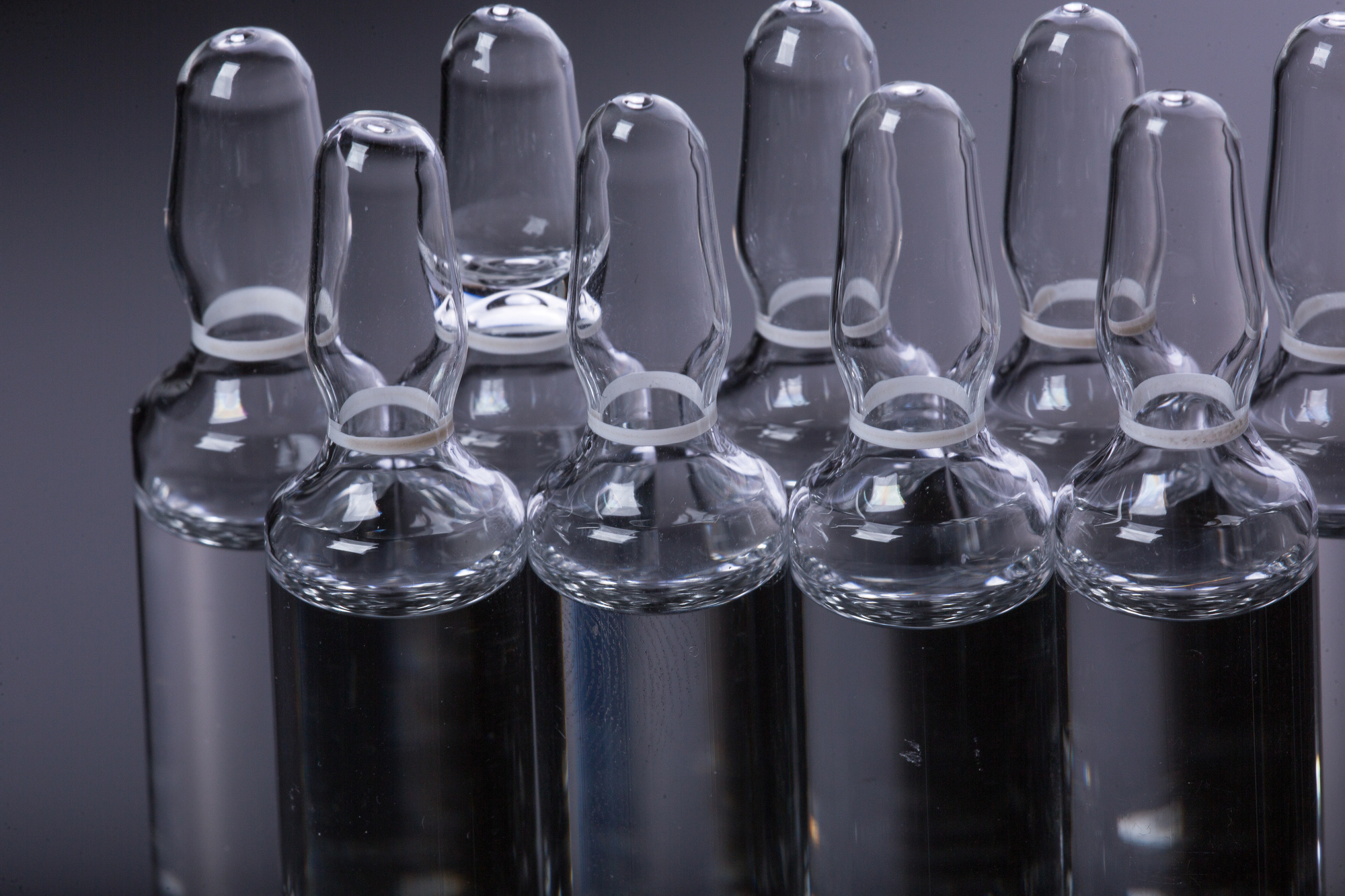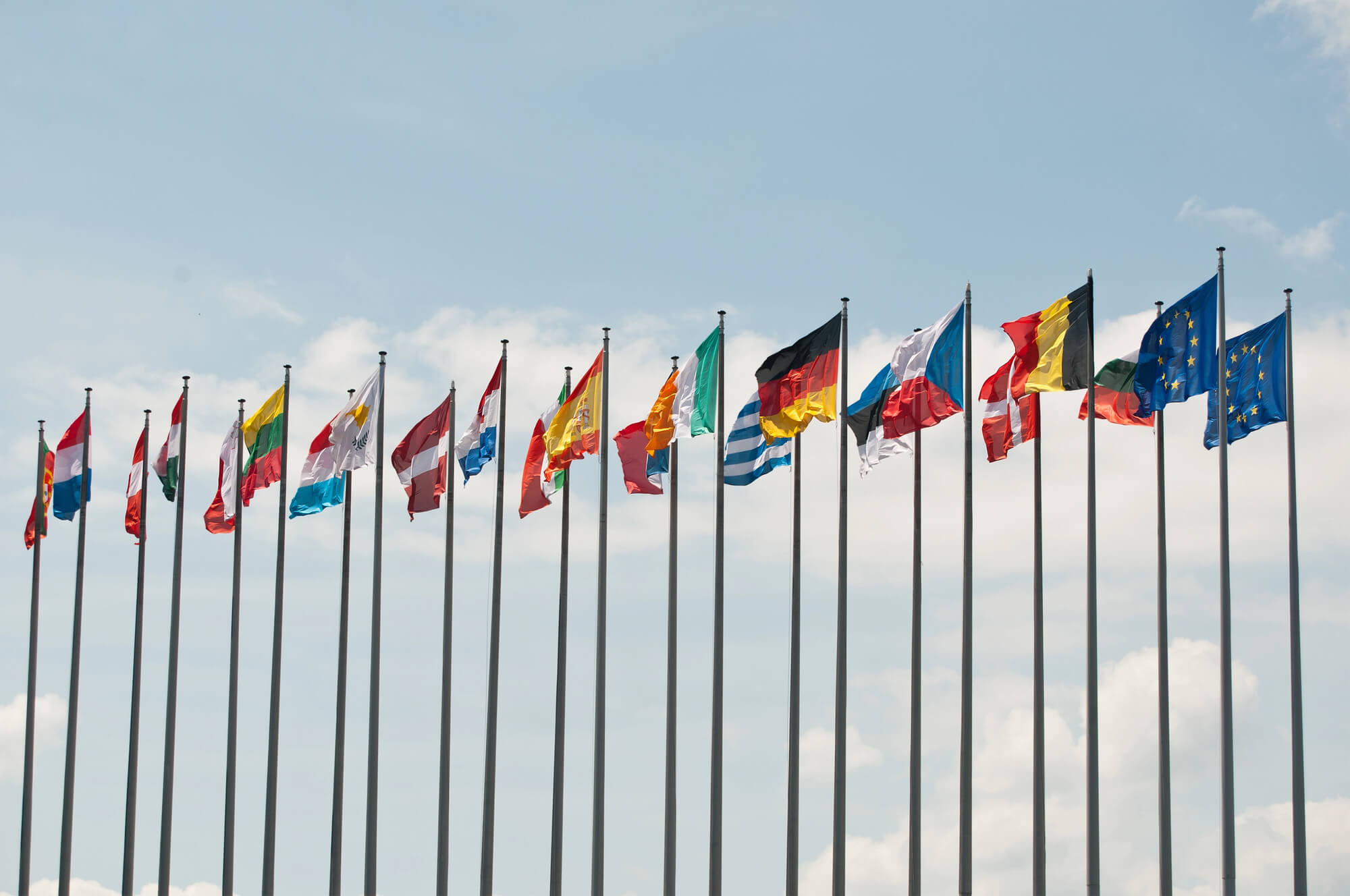Ukraine continues its gradual path toward membership in the European Union, but this path is accompanied by resistance, myths, and fears propagated by politicians and citizens of certain member states. The most significant concern lies in the economic dimension: will Ukraine become a burden on the EU budget, or, conversely, will it open new opportunities for the development of the entire Union? In this article, we analyze where the narratives about Ukraine as a burden come from, who promotes them, and why Ukraine’s accession to the EU is an investment, not a loss.
Hungary
On March 20, 2025, Hungarian Prime Minister Viktor Orbán stated on his X page that Ukraine’s EU membership would cost each Hungarian household 500,000 forints (1,200 euros) annually:
“9,000 billion HUF – that’s how much the war has already cost Hungarian families. 500,000 HUF per household, every year – that’s the price tag of Ukraine’s EU membership. Brussels wants Hungarians to pay the bill, but no decision will be made without the voice of the Hungarian people. A new member can only join with the unanimous support from all Member States. There can be no decision until the Hungarian people cast their votes. This decision belongs to our citizens, not Brussels!”
Screenshot of the post
First of all, where does this data come from? These are calculations by the Századvég Foundation, a think tank affiliated with Orbán. According to the foundation, “Ukraine has cost each Hungarian household 2.2 million HUF” (5,500 euros) or 9,000 billion HUF (22.5 billion euros) in total. The basis for the supposed losses includes three components: rising prices for imported gas, increased state spending due to higher yields on government bonds, and losses from reduced exports to Russia.
In reality, it refers to increased prices for imported gas due to changes in spot prices at the TTF Gas Hub in the Netherlands and additional budget expenditures due to the higher cost of state debt (due to geopolitical risks and inflation shocks, the yield on 5-year Hungarian government bonds rose from 2% to 4–6%). Additionally, bilateral sanctions – imposed by the EU on Russia and by Russia on the EU – affected Hungary’s trade volumes with the aggressor state. However, the root cause of these losses – Russia’s full-scale invasion of Ukraine – is not mentioned in the Századvég Foundation’s analysis.
Secondly, what does 500,000 HUF (1,250 euros) from each Hungarian household for Ukraine’s EU accession mean? In reality, Ukraine will not “take” money from every Hungarian family. It is more about potentially foregone aid from the EU budget that the country currently receives, and possible increased expenditures from Hungary’s state budget.
These calculations are based on the potential reduction in receipts from the EU Cohesion Fund and subsidies under the Common Agricultural Policy (CAP), contributions to support Ukraine amounting to 0.25% of GDP, additional pension costs for Ukrainians who supposedly will move to Hungary, and estimates of Hungary’s share in financing Ukraine’s reconstruction.
In general, there are several issues with the 500,000 HUF figure:
- They are based on the assumption that Ukraine would join the EU today. In reality, the years leading up to Ukraine’s EU integration will bring changes both in Ukraine (for example, we need to harmonize legislation with EU standards) and in the EU itself. By the time of Ukraine’s accession, both the CAP and the distribution of Cohesion Fund expenditures will likely have been significantly revised. Discussions on such revisions have already begun.
- Reconstruction costs for Ukraine are a separate international initiative, not part of the EU accession process, and not solely the responsibility of member states. Therefore, treating them as “future losses” for the population related to Ukraine’s EU accession is unfounded and manipulative.
- The calculations of migration and pension burdens are based on speculative assumptions. For example, the claim that 5% of Ukrainian pensioners will move to Hungary. According to the UN High Commissioner for Refugees, at the end of February 2025, the share of Ukrainians who chose Hungary as a refuge was about 1% of the total number of refugees in European countries.
Finally, the estimates by the Századvég Foundation do not consider the positive economic effects of enlargement: new markets, investments, enhanced security, and stability in the region. According to IMF calculations, EU enlargement, particularly due to the integration of Ukraine, Moldova, and the Balkan countries, could increase the bloc’s GDP by 14% over 15 years.
By the way, Hungary’s accession to the EU in 2004 also involved both pre-accession financial aid and post-accession funding to support its integration and development through three programs: ISPA (Instrument for Structural Policies for Pre-Accession), PHARE (Poland and Hungary: Aid for Restructuring of the Economies), and SAPARD (Special Accession Programme for Agriculture and Rural Development). Between 1990 and 2006, Hungary received €1.987 billion (in prices of that time). But even after joining, the country continued to receive support — financial aid for 2021–2027 is planned at around €30 billion.
Hungary receives several times more from the Cohesion Fund and other EU funds than it contributes to the EU budget. Its contribution is relatively small (about €2 billion with a GDP of more than €200 billion), while the amount received is one of the highest in the EU among recipient countries (after subtracting contributions, Hungary received around €4.5 billion from the EU budget in 2023). If calculated per capita, each Hungarian hypothetically gives “out of their pocket” about €200, while receiving nearly €700.
Poland and Slovakia
Concerns and myths about Ukraine’s accession to the European Union exist not only in Hungary. Polish presidential candidate from the opposition party Law and Justice (PiS), Karol Nawrocki, stated that Poland cannot afford actions that would harm its economy:
“At the same time, Poland represents — and I want this to be understood — its interests and society. Therefore, it cannot afford actions that would strike our economy, agriculture, or the wealth of Polish wallets.”
Russian propaganda media, citing Nawrocki’s interview for Sieci, picked up on the narrative that Ukraine’s EU membership would be economically disadvantageous for Poland.
Polish journalist and commentator Łukasz Warzecha pointed out that large amounts of money would go to Ukraine, which would be a direct competitor to Poland:
“Imagine this: in a few years, in a prospective new budget, Poles will have to pay not only gigantic sums due to the EU’s absurd climate policy, but will also be informed that tens of billions of euros of our money will flow into Ukraine, which will be our direct competitor in the bloc.”
In Slovakia, social media users circulated several false claims about the negative impact of Ukraine’s accession to the EU on the national economy. In particular, they manipulated the words of MP Ľubica Karvašová from the “Progressive Slovakia” party, who said that Slovak farmers would have to grow different products if Ukraine joins the EU. Social media users claimed the politician proposed that farmers grow camels and oranges. The post added that farmers would go bankrupt because Ukraine would supply products that Slovaks have “been growing for centuries”.
Slovak politician and deputy chair of the “Hungarian Alliance”, György Gyimesi, claims that under current rules, Cohesion Fund money is allocated to those member states where GNI (gross national income) per capita is below 90% of the EU average:
“Ukraine’s accession, considering its low level of development, would lower the EU’s average level of development overall. This would mean some current beneficiary countries would no longer be eligible for funding. At the same time, their actual level of development would remain unchanged, but those member states that stayed below the threshold would receive less money,” he wrote.
He also noted that if Ukraine joined the EU, supposedly 30% of all money allocated under the Common Agricultural Policy would go to Ukraine. Gyimesi concluded that if Ukraine joined the EU, it would become the largest beneficiary of the EU budget:
“If the EU wanted to raise the GDP of a completely destroyed Ukraine to the level of its weakest member, Bulgaria, according to calculations, it would cost each EU citizen €600,” the statement read.
A new formula for solidarity: transform, not compete
It is precisely the allocation of funds from these programs – the European Structural and Investment Funds and within the CAP – that Ukraine’s Eastern European neighbors mainly refer to when discussing potential losses (or rather, forgone income) for their households.
For example, the Cohesion Fund supports EU member states with a Gross National Income (GNI) per capita below 90% of the EU-27 average to strengthen the EU’s economic, social, and territorial cohesion. Under the current 2021–2027 program, 15 out of 27 countries are eligible for funding (Bulgaria, Czechia, Estonia, Greece, Croatia, Cyprus, Latvia, Lithuania, Hungary, Malta, Poland, Portugal, Romania, Slovakia, and Slovenia). And the allocation of funds within the CAP depends on the area of arable land and the number and size of farming households.
Currently, all EU spending estimates related to Ukraine’s accession are based on the “here-and-now” assumption, that is, they consider the country’s current economic status, relative population size, and the configuration of the current EU institutional system. Under these assumptions, the potential volumes of support are impressive. For instance, according to estimates of researchers from the German Economic Institute in Cologne, if Ukraine had been an EU member in 2023, it would have received €130–190 billion: €70–90 billion in agricultural aid and €50–90 billion under cohesion regional policy. EU estimates are similar – €186 billion.
A transformation of budget priorities always accompanies EU enlargement. However, these changes are not a burden but an investment in economic, social, and political stability across the continent. Even before new members join, the EU begins investing in their transformation: supporting reforms, strengthening institutions, and modernizing infrastructure.
The example of Croatia, which joined the Union in 2013, demonstrates the effectiveness of this approach. Between 2007 and 2013, it received €998 million under the Instrument for Pre-Accession Assistance (IPA). After accession, Croatia received €12.2 billion through the European Structural and Investment Funds (ESIF), of which €9.1 billion came from EU Cohesion Policy funds. Additionally, in 2014–2020, Croatia received €2.3 billion under the EU’s Common Agricultural Policy (CAP) Rural Development Programme.
The EU assisted Croatia in building institutional capacity, focusing primarily on preparing government institutions to comply with EU legislation and meet necessary criteria. The main focus was accelerating reforms in key areas such as the judiciary, anti-corruption, public administration reform, public finances, economic restructuring, and the business environment.
This strengthened the Croatian economy and the EU single market, into which local businesses integrated, expanding production chains. Accordingly, trade volumes increased. Add to this the new labor force and strengthened EU influence in the region. Croatia’s EU accession became a signal to other Balkan countries about the possibility of integration, provided reforms are implemented.
Under current conditions, Ukraine could become a net recipient of aid. At the same time, European countries that currently receive support would lose it, since Ukraine has the lowest GNI per capita and a high share of arable land. To integrate current candidates (which, in addition to Ukraine, include Moldova, Balkan countries, and Georgia), the EU needs to improve the efficiency of resource allocation. The EU budget and structural funds should consider current country indicators, growth potential, strategic importance, and benefits to the entire European Union.
Scholars and experts believe that if the EU enacts institutional reform, the costs of adapting Ukraine will be lower. Moreover, the efficiency of Ukraine’s agricultural sector is underestimated, and thus, subsidies for Ukrainian farmers may be significantly lower than the cited estimates.
Support for less developed regions is not only a matter of solidarity but also a mechanism for developing the internal market: new consumers and producers, reduced migration pressure, and strengthened regional security. People stay to live and work at home while purchasing goods produced in other EU countries.
Ukraine will bring unique assets to the EU: digital transformation, military resilience, flexible institutions, and civic engagement. While some European countries are slowly adapting to changes, Ukraine is already acting as a transformation accelerator.
Yes, integration requires investment. But these are investments in a new market, new energy, and a more resilient European space. Ukraine is not a “beneficiary” but a partner capable of strengthening and renewing the European Union.
Photo: depositphotos.com/ua
Attention
The authors do not work for, consult to, own shares in or receive funding from any company or organization that would benefit from this article, and have no relevant affiliations





